Symbolism
 |
 |
 |
 |
 |
 |
 |
The Bursting Pomegranate:
Symbol of the Resurrection
In Greek mythology, the pomegranate features prominently in the story of Persephone, daughter of Zeus, who was abducted by the god Hades of the underworld. Persephone's mother Demeter, the goddess of the harvest, became so distraught over the loss of her daughter that she refused to regenerate the earth and thus nothing would grow.
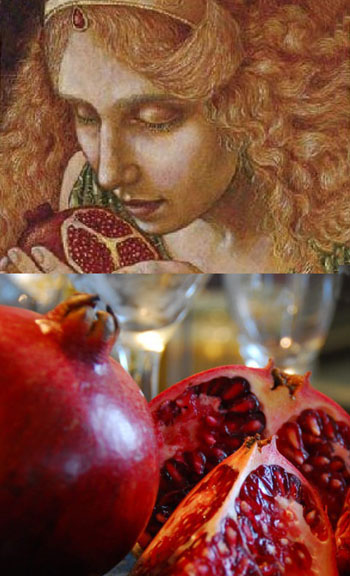 Zeus then commanded Hades to allow the beautiful maiden to return to her home. But Persephone was tricked by Hades into eating six pomegranate seeds offered to her by Hades. Because she had tasted those few seeds of the underworld, she was forced forever to remain six months of the year there, the cold months of Autumm and Winter when the earth becomes barren.
Zeus then commanded Hades to allow the beautiful maiden to return to her home. But Persephone was tricked by Hades into eating six pomegranate seeds offered to her by Hades. Because she had tasted those few seeds of the underworld, she was forced forever to remain six months of the year there, the cold months of Autumm and Winter when the earth becomes barren.
But each Spring she was allowed to return to earth in the months when the fruits and crops grow and are harvested. Thus, the pomegranate became a symbol of death and rebirth.
In the Church
From the time of the early Church, the pomegranate was understood as signifying the Passion and Resurrection of Christ. The terminal point on the orb-shaped fruit forms a heraldic crown, a sign of His royalty. When the deep red shell bursts open,the seeds bleed forth a deep red juice, a symbol of Christ's Precious Blood. He offered His last drop for our salvation. The burst-open rind is the open tomb on Easter morning, the proof of Christ's triumph over death.
The pomegranate's association with Christ's Resurrection made it a common symbol in art in the Middle Ages. Often the Christ Child seated on His Holy Mother's lap is shown holding a pomegranate, the symbol that prefigures Christ's Passion and Resurrection.
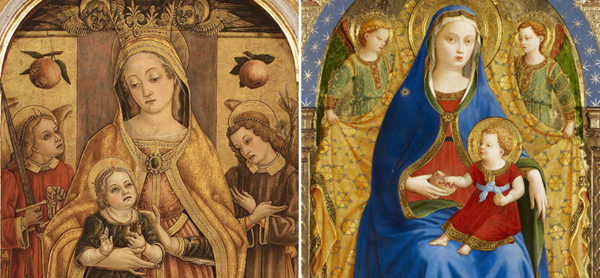 The Madonna con Bambino by Carlo Crivelli, above left, shows the bursting pomegranate in the upper left side, the sign of the promise of Redemption given to man by the Christ Child
who is seated in the Virgin's lap.
The Madonna con Bambino by Carlo Crivelli, above left, shows the bursting pomegranate in the upper left side, the sign of the promise of Redemption given to man by the Christ Child
who is seated in the Virgin's lap.
An even more beautiful representation is the painting by Fra Angelico titled The Virgin with the Pomegranate, above right. In it, the Christ Child is depicted taking a handful of the blood red seeds from the burst pomegranate in her hand. The gesture signifies his readiness to undergo the Passion and shed His Blood for mankind. Added to this is an even more poignant gesture: He receives the fruit from His Mother, the Co-Redeemer, who participates so closely in His Passion and the triumph of His Resurrection.
As the devotion to the Sacred Heart spread in the 19th century, the deep red fruit, because of its shape and color, also became a symbol of the Heart of Jesus.
Introduction to the New World
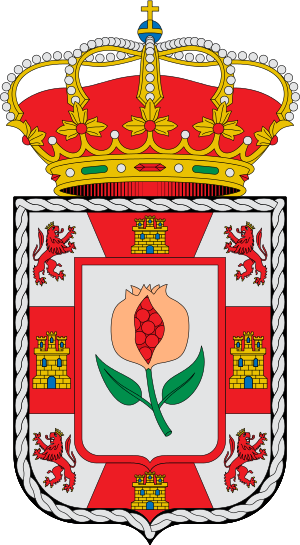 The pomegranate is a popular symbol in the Spanish city of Granada. The word granada in Spanish actually means pomegranate, and some believe the city was named after the fruit. The word is said to come from the Latin granum (seed), though others say it derives from Arabic. The word pomegranate in English is believed to have come from the Latin pomum (apple) and granum (seed).
The pomegranate is a popular symbol in the Spanish city of Granada. The word granada in Spanish actually means pomegranate, and some believe the city was named after the fruit. The word is said to come from the Latin granum (seed), though others say it derives from Arabic. The word pomegranate in English is believed to have come from the Latin pomum (apple) and granum (seed).
At any rate, when Queen Isabella and King Ferdinand conquered the last stronghold of the Muslims in Granada in 1492, they considered it so significant an event that a pomegranate was added to the Province’s coat of arms.
The Hospitaller Order of St. John of God, born in the Spanish city of Granada, also uses the fruit – “God's fruit” – as its symbol.
Thus, Spanish colonists introduced the pomegranate to the Americas shortly after the Discovery. Later, Spanish missionaries brought pomegranate seeds with them to Arizona, California and Texas, where the trees still flourish.
It is a recurring motif in Spanish art and literature, appearing on chests, textiles, ceramics, jewelry and, of course, paintings throughout colonial Spanish America.
An Old Testament symbol
The pomegranate, which appears various times in the Old Testament, has always been imbued with meaning. They are among the fruits God mentions when speaking to the Israelites of the Promised Land, “a land of wheat and barley, vines and fig trees, pomegranates, olive oil and honey” (Deut 8:8).
In fact, pomegranates were among the fruits brought by the spies to the Israelites wandering in the desert (Numbers 13:23). In his Song of Songs, Solomon compares them to the temples of man: “Your temples behind your veil are like the halves of a pomegranate.” (4:3)
 The pomegranate is mentioned specifically in the Old Testament in the instructions God gave on how to make the robes the high priest Aaron should wear when he entered the Holy Place: “Make pomegranates of blue, purple and scarlet yarn around the hem of the robe, with gold bells between them.” (Ex 28:35)
The pomegranate is mentioned specifically in the Old Testament in the instructions God gave on how to make the robes the high priest Aaron should wear when he entered the Holy Place: “Make pomegranates of blue, purple and scarlet yarn around the hem of the robe, with gold bells between them.” (Ex 28:35)
The Israelites believed the pomegranate had 613 seeds, corresponding to the number of commandments of the Torah. Thus, the high priest Aaron wore a robe decorated with this fruit, which represented the Law. King Solomon also ordered pomegranates to be carved on the two bronze columns in the Temple named Boaz and Jachin, which means “In its strength” and “He will establish.” Again, the fruit was used to symbolize the Law upholding the Temple and the Israelite people. (1:Kings 7:18)
A new interpretation: Many people under one authority
But, the Old Law was replaced by the New with the Death and Resurrection of the Savior. And so, we still find the pomegranate appearing quite often in the Middle Ages embroidered on priest's vestment and altar cloths, but now with new significance.
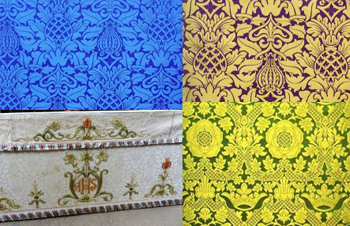 The many seeds contained in its casing made the fruit a symbol of the unity of the Church, the many peoples under one authority. Thus are Catholic souls safely contained and bound together in the community of the one true Church; they are represented by the priest – alter Cristus – on the altar.
The many seeds contained in its casing made the fruit a symbol of the unity of the Church, the many peoples under one authority. Thus are Catholic souls safely contained and bound together in the community of the one true Church; they are represented by the priest – alter Cristus – on the altar.
Pomegranate designs are still found on clerical vestments and altar linens today. One of most popular damask fabrics is the Fairford pattern, a Victorian Gothic pattern with rows of pomegranates and pineapples.
Once you recognize the deep significance of the pomegranate, you will start to see it in many places in churches and appreciate the rich symbolism of this exotic, exquisite fruit.
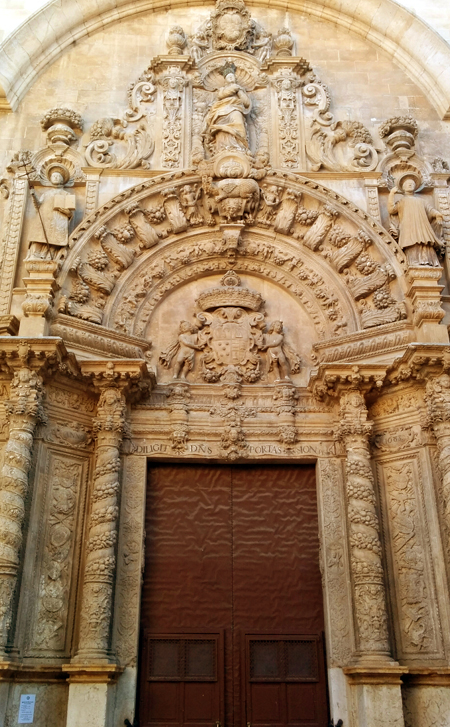


Persephone could not resist tasting a pomegranate in the underworld
But each Spring she was allowed to return to earth in the months when the fruits and crops grow and are harvested. Thus, the pomegranate became a symbol of death and rebirth.
In the Church
From the time of the early Church, the pomegranate was understood as signifying the Passion and Resurrection of Christ. The terminal point on the orb-shaped fruit forms a heraldic crown, a sign of His royalty. When the deep red shell bursts open,the seeds bleed forth a deep red juice, a symbol of Christ's Precious Blood. He offered His last drop for our salvation. The burst-open rind is the open tomb on Easter morning, the proof of Christ's triumph over death.
The pomegranate's association with Christ's Resurrection made it a common symbol in art in the Middle Ages. Often the Christ Child seated on His Holy Mother's lap is shown holding a pomegranate, the symbol that prefigures Christ's Passion and Resurrection.

Left, Madonna con Bambino by Crivell; right, Virgin with the Pomegranate by Fra Angelico
An even more beautiful representation is the painting by Fra Angelico titled The Virgin with the Pomegranate, above right. In it, the Christ Child is depicted taking a handful of the blood red seeds from the burst pomegranate in her hand. The gesture signifies his readiness to undergo the Passion and shed His Blood for mankind. Added to this is an even more poignant gesture: He receives the fruit from His Mother, the Co-Redeemer, who participates so closely in His Passion and the triumph of His Resurrection.
As the devotion to the Sacred Heart spread in the 19th century, the deep red fruit, because of its shape and color, also became a symbol of the Heart of Jesus.
Introduction to the New World

Arms of the Province of Granada
At any rate, when Queen Isabella and King Ferdinand conquered the last stronghold of the Muslims in Granada in 1492, they considered it so significant an event that a pomegranate was added to the Province’s coat of arms.
The Hospitaller Order of St. John of God, born in the Spanish city of Granada, also uses the fruit – “God's fruit” – as its symbol.
Thus, Spanish colonists introduced the pomegranate to the Americas shortly after the Discovery. Later, Spanish missionaries brought pomegranate seeds with them to Arizona, California and Texas, where the trees still flourish.
It is a recurring motif in Spanish art and literature, appearing on chests, textiles, ceramics, jewelry and, of course, paintings throughout colonial Spanish America.
An Old Testament symbol
The pomegranate, which appears various times in the Old Testament, has always been imbued with meaning. They are among the fruits God mentions when speaking to the Israelites of the Promised Land, “a land of wheat and barley, vines and fig trees, pomegranates, olive oil and honey” (Deut 8:8).
In fact, pomegranates were among the fruits brought by the spies to the Israelites wandering in the desert (Numbers 13:23). In his Song of Songs, Solomon compares them to the temples of man: “Your temples behind your veil are like the halves of a pomegranate.” (4:3)

Pomegranates alternating with bells on the robe of the high priest Aaron
The Israelites believed the pomegranate had 613 seeds, corresponding to the number of commandments of the Torah. Thus, the high priest Aaron wore a robe decorated with this fruit, which represented the Law. King Solomon also ordered pomegranates to be carved on the two bronze columns in the Temple named Boaz and Jachin, which means “In its strength” and “He will establish.” Again, the fruit was used to symbolize the Law upholding the Temple and the Israelite people. (1:Kings 7:18)
A new interpretation: Many people under one authority
But, the Old Law was replaced by the New with the Death and Resurrection of the Savior. And so, we still find the pomegranate appearing quite often in the Middle Ages embroidered on priest's vestment and altar cloths, but now with new significance.

Fabrics for priest vestments and an altar cloth with pomegranate designs
Pomegranate designs are still found on clerical vestments and altar linens today. One of most popular damask fabrics is the Fairford pattern, a Victorian Gothic pattern with rows of pomegranates and pineapples.
Once you recognize the deep significance of the pomegranate, you will start to see it in many places in churches and appreciate the rich symbolism of this exotic, exquisite fruit.

Pomegranates engraved in the columns of an ancient Church in Palma de Mallorca

Posted April 29, 2019
______________________
______________________











